Mountaintop removal mining
Добывающая промышленность
Diamond Geology & Kimberlites
Kimberlite Pipes
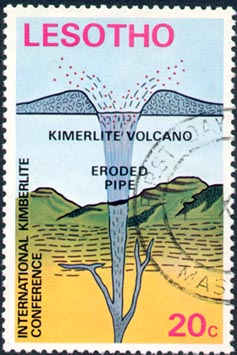 Diamonds form about 100 miles (161 km) below the Earth's surface, in the molten rock of the Earth's mantle, which provides the right amounts of pressure and heat to transform carbon into diamond. In order for a diamond to be created, carbon must be placed under at least 435,113 pounds psi (30 kilobars) of pressure at a temperature of at least 752 Fahrenheit (400 Celsius). If conditions drop below either of these two points, graphite will be created. Most diamonds that we see today were formed millions (if not billions) of years ago. Powerful magma eruptions brought the diamonds to the surface, creating kimberlite pipes.
Diamonds form about 100 miles (161 km) below the Earth's surface, in the molten rock of the Earth's mantle, which provides the right amounts of pressure and heat to transform carbon into diamond. In order for a diamond to be created, carbon must be placed under at least 435,113 pounds psi (30 kilobars) of pressure at a temperature of at least 752 Fahrenheit (400 Celsius). If conditions drop below either of these two points, graphite will be created. Most diamonds that we see today were formed millions (if not billions) of years ago. Powerful magma eruptions brought the diamonds to the surface, creating kimberlite pipes.
Kimberlite is a diamondiferous igneous-rock matrix composed of carbonate, garnet, olivine, phlogopite, pyroxene, serpentine, and upper mantle rock, with a variety of trace minerals. It occurs in the zone of the Earth's crust in vertical structures known as kimberlite pipes. These are found as "dikes" and "volcanic pipes" which underlie and are the source for rare and relatively small volcanoes or "maars".
The name "Kimberlite" was derived from the South African town of Kimberly where the first diamonds were found in this type of rock conglomeration.
Open Pit Mining
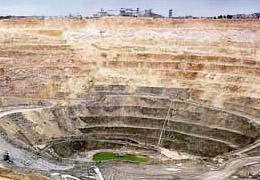 The most commonly used extraction method for diamondiferous material is the open mine technique. Open pit procedures are to loosen and haul the diamond rich material for further sorting and processing. The very geometry of the kimberlite pipe supports this method in which layers of the earth are removed and then benched down to a lower level connected via roads. The kimberlite pipe narrows with depth, which supports open mining processes since open pits need to also narrow as the mine becomes deeper.
The most commonly used extraction method for diamondiferous material is the open mine technique. Open pit procedures are to loosen and haul the diamond rich material for further sorting and processing. The very geometry of the kimberlite pipe supports this method in which layers of the earth are removed and then benched down to a lower level connected via roads. The kimberlite pipe narrows with depth, which supports open mining processes since open pits need to also narrow as the mine becomes deeper.
Surficial strata is soft enough for direct digging and ripping while underlying layers become harder and explosives must be utilized.
Processing
There are several steps that the raw mined material must endure before it is cut and polished for display. The first step of processing is to haul the diamondiferous material to the modular processing plant. This plant is normally extremely close to the open pit mine and material is transported with massive dump trucks and loaders.
Crushing and Milling
The conglomerate is put into a large crushing machine and smashed until the crystals are released. Milling the material is more suitable for some deposits: it is a process where the diamondiferous material is placed in rotating drums with water. The material slowly disintegrates leaving only raw diamonds.
Washing, Screening, and Heavy Media Separation
Washing is the next step for removing yet finer diamonds from the abundance of mined diamond ore. Screening is best known from the gold rush days. A screen of known size is placed beneath the material as it is tumbled allowing only a certain diameter of particles to pass through.
The Grease Belt and X-Ray Separation
The grease belt was established on the property of most raw diamonds to stick in grease because they were non-wettable while all other material would not. Using a 3-foot wide belt coated with grease, soaked diamondiferous material is transported in thin layers, revealing raw crystals. The grease is then mechanically scraped from the belt as a fresh layer is added, allowing continual movement.
Russian scientists developed a method in the late 1950's that extracted diamonds based on their luminescence. The material is fed into a machine that runs it under X-ray radiation. If a diamond lights up, a photo-electric cell is triggered which opens a corresponding gate that drops the diamond out of the conglomerate.
Упражнение 1
Переведите на русский:
Earth's mantle, kimberlite pipes, diamondiferous igneous-rock matrix, garnet, Earth's crust, dikes, volcanic pipes, maars, alluvial diamond placer deposits, oxbow lakes, river terrace gravels, abandoned river meanders, the “forbidden territory”, ripping, benches, underground mining, dump trucks, loaders, crushing, milling, rotating drums, non-wettable, luminescence.
What Are Diamonds?
Diamonds are the crystallized form of carbon created under extreme heat and pressure. It's this same process that makes diamonds the hardest mineral we know of. A diamond ranks a 10 on the Mohs Hardness Scale. The Mohs Scale was named after the German mineralogist Friedrich Mohsand is used to determine the hardness of solids, especially minerals:
Here's the scale, from softest to hardest:
Talc - easily scratched by the fingernail
Gypsum - just scratched by the fingernail
Calcite - scratches and is scratched by a copper coin
Fluorite - not scratched by a copper coin and does not scratch glass
Apatite - just scratches glass and is easily scratched by a knife
Orthoclase - easily scratches glass and is just scratched by a file
Quartz - (amethyst, citrine, tiger's-eye, aventurine) not scratched by a file
Topaz - scratched only by corundum and diamond
Corundum - (sapphires and rubies) scratched only by a diamond
Diamond - scratched only by another diamond
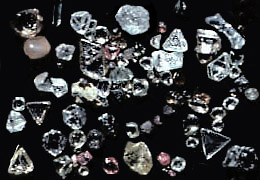 Alluvial Diamonds from Africa Alluvial Diamonds from Africa | 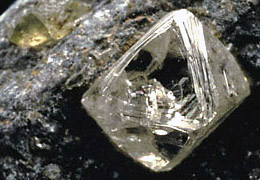 Diamonds in Kimberlite Matrix Diamonds in Kimberlite Matrix |
Cutting Diamonds
There are special techniques that are used to cut and shape a diamond before it gets to the jewelry store. Diamond cutters use these four basic techniques:
Cleaving - To cut a rough diamond down to a manageable size, the cutter must cleave it along the diamond's tetrahedral plane, where it is the weakest. A wax or cement mold holds the diamond in place while the cutter carves a sharp groove along the plane. The cutter places a steel blade in the groove and forcefully strikes it, cutting the rough diamond in two.
Sawing - Sometimes, diamonds have to be cut where there is no plane of weakness, which cannot be done with cleaving. Instead, the cutter saws the diamond using a phosphor-bronze blade rotating at about 15,000 rpm. Lasers can also be used to saw diamonds, but the process takes hours. During the sawing step, the cutter decides which parts of the diamond will become the table (the flat top of the stone with the greatest surface area) and the girdle (the outside rim of the diamond at the point of largest diameter). Then, he proceeds to cutting.
Bruiting/Cutting - This technique gives diamonds their shape. When diamonds are cut by hand, the technique is called bruiting – cutting refers to bruiting by machine. When the cutter shapes diamonds by hand, he relies on the diamond's hardness as his tool – he uses diamonds to cut diamonds. He uses a small, stick-like instrument with a cement-filled bowl at the tip to hold the diamond. The diamond is inserted in cement with just one corner exposed. Using one of these sticks in each hand, the cutter rubs the exposed diamond parts together to bruit them. In the mechanical process, the diamond is placed in a lathe, and another diamond in the lathe rubs against it to create the rough finish of the girdle.
Polishing - To create the diamond's finished look, the cutter places it onto the arm above a rotating polishing wheel. The wheel is coated with an abrasive diamond powder that smoothes the diamond as it is pressed against the wheel.
Упражнение 1
Переведите на русский:
Cleaving, a groove, sawing, the table, the girdle, cutting, bruiting, a lathe, polishing, the Mohs Hardness Scale, diamond powder.
Coal Mining
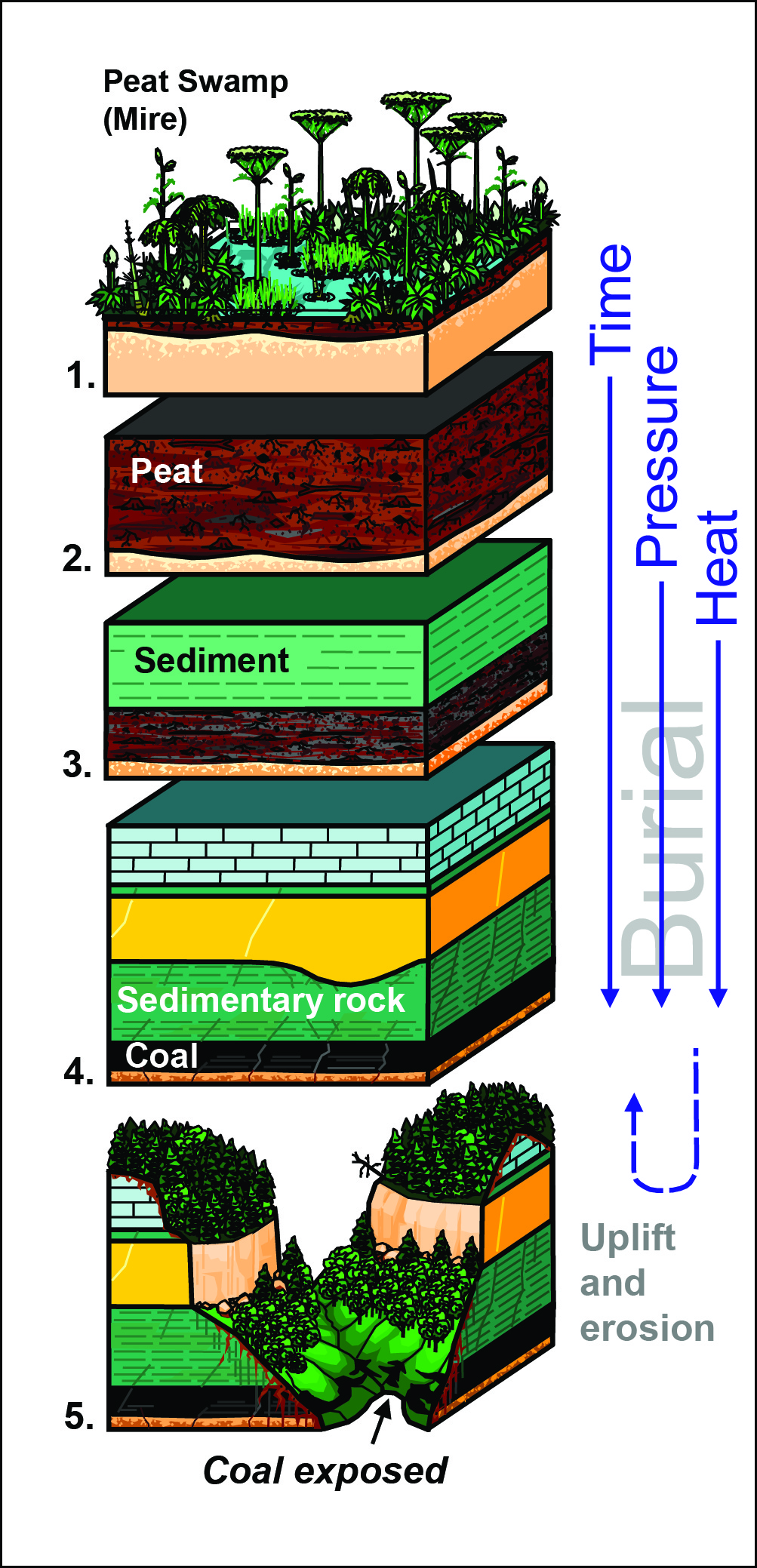 Over 6185 million tonnes (Mt) of hard coal is currently produced worldwide and 1042 Mt of brown coal/lignite. The largest coal producing countries are not confined to one region - the top five hard coal producers are China, the USA, India, Australia and South Africa. Much of global coal production is used in the country in which it was produced; only around 15% of hard coal production is destined for the international coal market.
Over 6185 million tonnes (Mt) of hard coal is currently produced worldwide and 1042 Mt of brown coal/lignite. The largest coal producing countries are not confined to one region - the top five hard coal producers are China, the USA, India, Australia and South Africa. Much of global coal production is used in the country in which it was produced; only around 15% of hard coal production is destined for the international coal market.
Coal energy accounts for 40% of electricity generation in America. Burning coal releases carbon dioxide, which is a greenhouse gas. Of all U.S. sources, coal currently accounts for a disproportionately large 80% of emissions released by electricity generation.
SURFACE MINING
Surface mining of coal - aka opencast mining - is only economic when the coal seam is near the surface. Large opencast mines use very large pieces of equipment, including:
· draglines, which remove the overburden
· power shovels
· large trucks, which transport overburden and coal
· bucket wheel excavators
The overburden of soil and rock is first broken up by explosives; it is then removed by draglines or by shovel and truck. Once the coal seam is exposed, it is drilled, fractured and systematically mined in strips. The coal is then loaded on to large trucks or conveyors for transport to either the coal preparation plant or direct to where it will be used.
LONGWALL MINING
Longwall Mining involves the full extraction of coal from a section of the seam, or 'face' using mechanical shearers. A longwall face requires careful planning to ensure favourable geology throughout the section before development work begins. The coal 'face' can vary in length from 100-350m. Self-advancing, hydraulic supports temporarily hold up the roof while coal is extracted. When coal has been extracted from the area, the roof is allowed to collapse.
MOUNTAINTOP REMOVAL MINING
Mountaintop Removal Mining (MTR) has become the preferred method for extracting coal in North America. This technique involves deforesting, exploding and clearing away the top layer of mountains in order to harvest coal from the seams buried underneath. The “overburden” is either used in the reshaping of the ridge or is dumped into an adjacent valley, becoming “valley fill.”
A dragline bucket excavator is used to extract “spoils,” the material immediately surrounding the coal. The dragline is one of the largest mobile machines ever built, weighing between 2,000 and 13,000 tons and costing between $50 and 100 million dollars. Most draglines used in surface mining require a direct high-voltage connection, consuming up to 6 Megawatts of power during normal digging operations.
Water supplies in MTR regions are subject to twofold contamination—first, the streams are filled with MTR waste, which has been shown to contain heavy metals such as mercury, cadmium and nickel, and secondly, impoundments of coal slurry can seep into the groundwater. And as the streams toxify, organic material deteriorates, leaving the land vulnerable to flash flooding.
